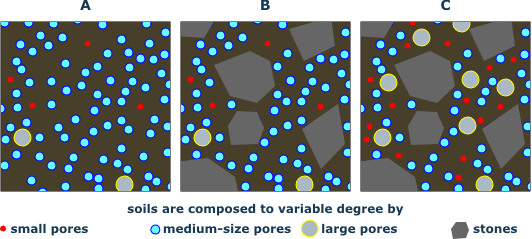Soils matter
The three drivers of moisture storage in soils are:
- depth: determines the potential storage volume
- stones: reduce the potential soil volume
- pore volume: determines the maximum volume of water stored per unit of fine substrate volume

- Fine substrate only and a predominance of medium size pores - the ideal substrate.
- Stones (> 2 mm) reduce the substrate volume.
- Water in pores which are too small cannot be extracted by plants, pores which are too large cannot hold the water, so it drains. Stones reduce the volume.
Alpine substrates are commonly rich in medium size pores and have a high water holding capacity (often around 50 %), however stones and shallow depth can cause problems.
Design your drought risk scenario:
Allow for
- a 500 mm soil depth,
- a medium size pore volume of 50 % and
- starting conditions with maximum water content (after coarse pores have drained)
and assume
- daily water loss by evapotranspiration of 4 mm during a completely rainless period.
Try the following:
- Vary your stone content between 0 and 80 % at constant soil depth.
- Vary your soil depth at a constant 50 % stone volume.
Note the effect on the stored water and the number of days this water can support a 4 mm daily water loss, as is typical for bright summer weather.
Now combine A and B (increase stone content and reduce depth).
Do you have a feeling for the key role soil depth and stones play in actual water relations of plants under a given precipitation regime?

